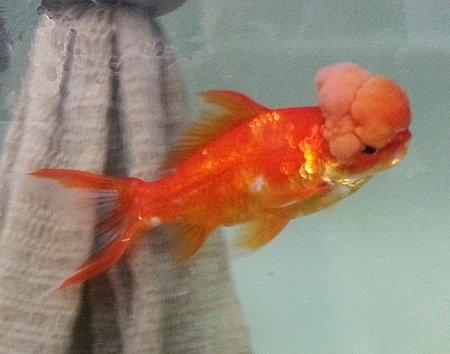| Back to Back Issues Page |
 |
|
The Goldfish Gazette, Issue #085 Identifying Your Variety January 30, 2021 |
Goldfish Care TipsA Free Monthly Resource For Goldfish Enthusiasts In This Issue There are over 100 known varieties of Goldfish, with only subtle differences between some of the more exotic varieties, but even the most common varieties can be mis-identified. Identifying Your Variety
Shubunkin with a WenOne of the most common differences of opinion on Facebook occurs when a group member asks for confirmation of what variety their Goldfish is.You would think most of the discussions would revolve around very exotic varieties, but not so. One of the most recent heated discussions was whether a fish was a Common, or a Comet. One member of the group had a good argument that the fish had rounded ends to the caudal fin and Comets had pointed ends therefore the fish was a Common. On the other side, it was argued the caudal fin was too long to be a Common Goldfish, so it was a Comet. Both sides were incorrect. The fish wasn’t a Common because the caudal fin was far too long, and it wasn’t a Comet because the caudal fin was indeed rounded, similar to a Bristol Shubunkin. The fish was a cross of unknown parentage as the body was deeper than normal for a Common or Comet. Poor Quality Pet Shop FishMost pet shops have little idea of the different Goldfish varieties, apart from the more obvious ones such as Comets, the most commonly sold Goldfish, and Black Moor. They know even less about what a quality fish looks like.The fish they sell are usually young, so the descriptions shown on the sales ticket may not be accurate. A good example is fish sold as Orandas. Are these fish Oranda that will develop a wen, or just fantails or Ryukins? The purchaser won’t know for certain for at least 12 months. The image above is of a fish I have had for a few years that I rescued when it was one inch long (25mm) and razor blade thin because its owner never fed it. I identified the fish as a very poor quality American/Japanese Shubunkin because of the pointed caudal fin and calico scale group. About 18 months ago a growth started appearing on its head. I assumed it was a tumor, but no, it was a wen, and a reasonably good one at that. So, what genetic makeup is involved with this fish, Oranda, Shubunkin? What we can assume is, most Goldfish on the market are what are referred to as pet shop quality, and many are the result of crosses or are fish that don't necessarily have all the characteristics of a particular variety. After hundreds of years of selective breeding, all fancy variety spawns will still produce some single tailed fry. Goldfish StandardsSo, how do we resolve these identification issues?The American Goldfish Association (AGA) and the Nationwide Goldfish Societies UK have compiled standards that describe what characteristics a variety should have. I have listed both as there are slight differences to some varieties. The standards were produced so judging at fish shows could be more consistent, and fish more easily classified, for example a Moor in the UK standards must be metallic scaled and black. These standards only cover 18-20 of the more common varieties, as the likelihood of a Celestial Pom Pon, yes, the variety does exist, appearing in a Goldfish show is highly unlikely. To learn more about Goldfish standards and for links to the AGA and UK standards click here…
Comments? Ideas? Feedback? I'd love to hear from you. Just reply to this e-zine and tell me what you think, or what topics you want covered. Next Month's Topic Repashy Gel Food Preparationwww.facebook.com/aboutgoldfish |
| Back to Back Issues Page |
